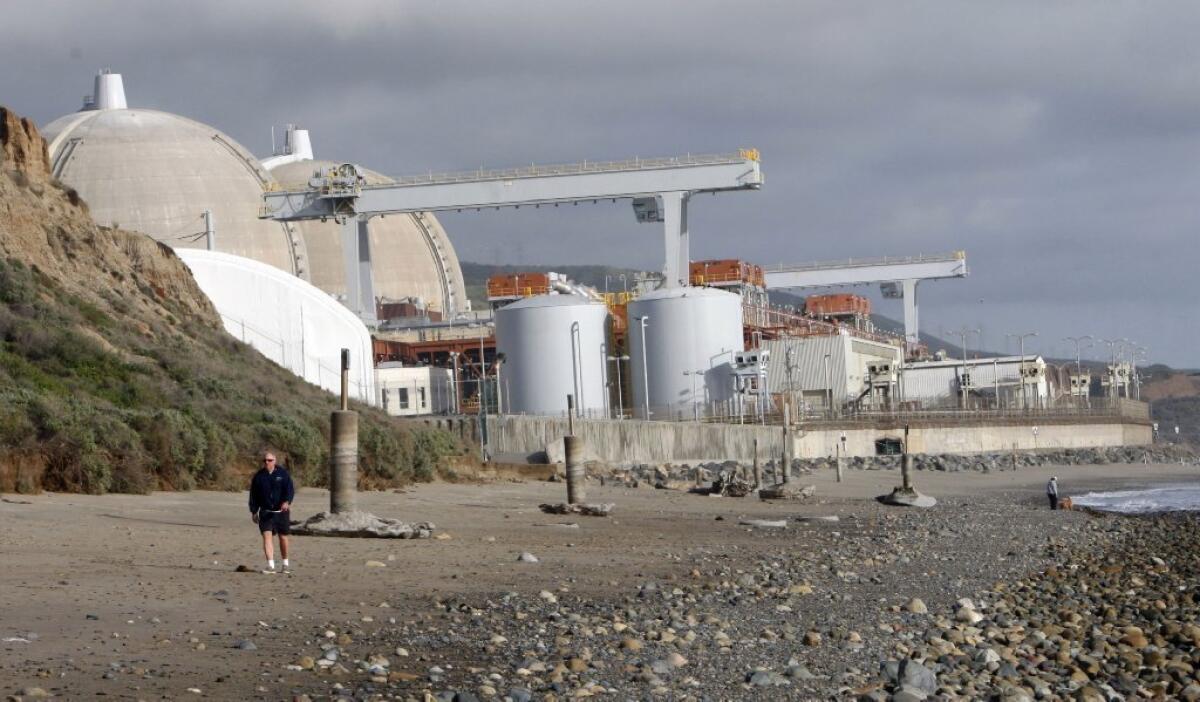San Onofre’s other problem

- Share via
The beleaguered San Onofre nuclear power plant north of San Diego has been idle since January 2012 after the discovery of unsafe reactor conditions. The operator is now seeking approval to restart one of the plant’s two reactors at 70% power for a five-month test. The plant’s license expires in less than 10 years.
Overlooked in the concerns about the short-term future of San Onofre are the 1,400 tons of spent nuclear fuel stored at the coastal site. Regardless of the immediate dilemma, San Onofre is destined to follow in the footsteps of nine former nuclear power plants (including two in California) whose reactors are long gone, but whose waste remains stranded on site. There’s nowhere else to put it.
This problem will only worsen. The fleet of aging U.S. nuclear reactors means that as many as 40 more reactors could be shut down in the next 15 years. Something needs to be done about the dangerous radioactive byproducts that will be left behind.
Meanwhile, the United States nuclear waste program is in shambles.
In 2010, after almost three decades of work and more than $15 billion spent, President Obama unilaterally shut down the proposed underground repository for nuclear waste at Yucca Mountain, Nev. That repository would have provided long-term disposal, as well as possible retrievability of the waste in the event that a safe and economical reprocessing technology became available.
Obama’s action set off a firestorm of bipartisan protests in Congress. In a standoff with the U.S. Court of Appeals, the Nuclear Regulatory Commission claims lack of funds to review the Yucca Mountain license application.
Even if a repository were approved tomorrow, it would take decades to construct and to transfer the existing waste to the site.
Currently, about 75% of San Onofre’s spent fuel is submerged in pools. As a result of the nuclear waste backlog, many U.S. pools contain five times the amount of fuel that they were designed to handle.
The dangers of pool storage came to worldwide attention during the 2011 disaster at Fukushima, Japan, which left operators unable to circulate water to cool the fuel or even monitor water levels in the pools. If spent fuel assemblies at a nuclear power plant are exposed to air and self-ignite, thousands of people within 50 miles of the facility could die from the radiation released, the NRC estimates.
Dry casks, which house the remaining 25% of San Onofre’s spent fuel, are less vulnerable than pools to natural disasters or terrorist attacks. At Fukushima, the dry casks survived the disaster unscathed. But they are not a permanent solution. Dry casks have a 50-year design life; spent nuclear fuel remains dangerous over hundreds of thousands of years or more.
As a geologic repository for the waste continues to recede into the ever-distant future, the NRC has considered new rules that would allow onsite storage for up to three centuries. Three centuries ago George Washington was not yet born.
Since 1976, California has maintained a moratorium on building nuclear power plants until a method for permanent disposal of spent fuel is assured. With 70,000 tons of spent nuclear fuel now scattered among 75 sites in 33 states, this skepticism is well founded.
These numbers don’t include the high-level waste from the nuclear weapons program. At Hanford, Wash., there’s enough high-level waste to fill the tanker cars of a train 26 miles long. And to top it off, more than 30 tons of excess weapon-grade plutonium at half a dozen sites across the U.S. must be disposed of.
It’s now more than half a century since the dawn of nuclear energy. As dangerous, long-lived nuclear waste piles up across the country, we continue to shift the burden to future generations.
Passing the problem on to others was not always the case. In the early years of nuclear energy, the United States committed to developing deep geologic repositories for isolation of long-lived radioactive wastes from humans and the environment. This commitment has waned over the years, leaving us with over-packed pools and stranded waste.
Regardless of one’s stance on nuclear energy, it is clear that we need to take responsibility for the nuclear waste we have generated and commit to its safe disposition.
William Alley oversaw the U.S. Geological Survey studies of Yucca Mountain from 2002 to 2010. He and Rosemarie Alley are the authors of “Too Hot to Touch: The Problem of High-Level Nuclear Waste.”
More to Read
A cure for the common opinion
Get thought-provoking perspectives with our weekly newsletter.
You may occasionally receive promotional content from the Los Angeles Times.









